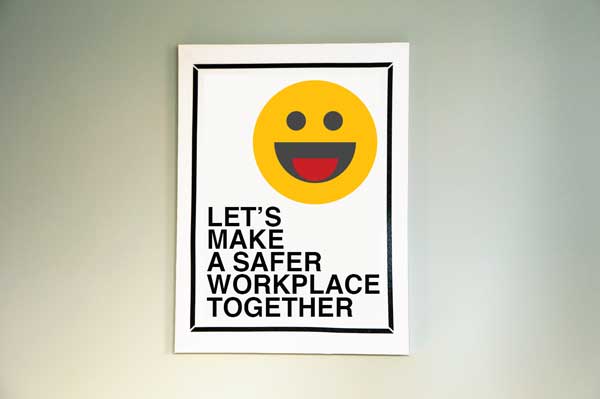One thing almost all of us in the health and safety industry can agree is true, is that safety doesn’t just happen. Much to the shock of many management teams and financial controllers, it takes a bit more than just banging out a manual and some policies, and assuming that everyone will magically follow them. We know, like you, it takes planning, know-how, and at times a bit of innovation to get an effective safety management system up and running in an organisation. That’s why, in this blog, we covered how to use communications tactics to support your safety program.
Certainly, there are some staples required for success in safety. We often speak about the necessity for your leadership to be actively promoting – and indeed living – safety. We also know about the importance of proper training and guidance from health and safety professionals of various areas of specialisation. And needless to say having clear, contextualised policies and procedures in place is paramount.
But an oftentimes-neglected component of the whole system is communication. By this we mean – how you convey what your safety management system is to your team, why it’s important, and how your team can be an active part of it, ultimately keeping everyone safer. After all, there’s no point having a great system in place if you don’t use communication tactics to explain what it’s all about and your team can easily absorb and understand.
What kinds of communication tactics should you be considering?
There are many ways you can communicate safety messages and it doesn’t have to be a full-blown internal safety campaign with all the bells and whistles. Sometimes, all it takes is a quick brainstorm to think about what ways will be best in your workplace, and for your teams. Remember, this may vary between workplaces, and even between teams.
Since an important part of getting people to absorb a message is to repeat it, regularly, and in a variety of ways, we’d recommend starting with the ways you can get your message embedded in ‘business as usual’. The more touch points your team experience with your safety message, the more likely they’ll remember it.
For example, consider the following;
- Do you have team meetings, weekly or monthly? Add a line item on the agenda to discuss your latest safety message.
- Do you have a newsletter that goes out to staff? Add a regular spot in there for safety messages.
- Does your CEO or another leader in the organisation send out organisational updates via email? Ensure that they too are speaking about your safety message.
- Do you use other communications tools like Whatsapp, Slack or SMS? Try sharing your message through those channels too – an image with a message might work well.
- Do you have a website or social media pages? Sharing your business’ safety values and culture publicly can be an effective way to encourage your team to get on board.
- Does your team use some software or a computer program regularly? Think about ways you could drop a safety message in there with pop ups when they login, alternatively can you configure a little message on the dashboard.
- Do you have tearooms or common spaces? Of course, there’s always room for a safety poster or two! Sharing your message in printed form is, and will always be, a great way to communicate as people take in messages in many different ways (it’s not always about digital, digital, digital!).
When might I need an internal safety campaign?
Internal safety campaigns are one tactic that many businesses adopt in order to convey key messages as part of their safety program. They often involve a creative agency or designer developing a series of communications materials that communicate your key message in a simple and very effective manner, perfectly suited to your needs. Usually a campaign will consist of a both printed and digital communication touch points, but might also include gimmicks, games or competitions to get your team really engaged with your safety message, for better retention.
Internal safety campaigns are often used in larger businesses or where your staff are distributed across several sites. They help ensure that everyone is getting a consistent message. Additionally, they might be adopted when you need a little more of a push when it comes to safety and are particularly effective if you are trying to change engrained or stubborn behaviours, or realign a negative workplace or safety culture.
Internal campaigns can also work very well when you are trying to communicate a newly developed safety program or trying to reinvigorate an existing one. They ensure that what’s written in your documentation, policies and procedures, actually make it into the hands or minds of your team. And if your safety program has many components to it, an internal safety campaign can help to share those different parts of the program at different points over a period of time. This way you can be sure to get your key safety messages across without overwhelming your team by hitting them with everything all at once.
Messaging considerations for safety communications
If you are thinking about running an internal safety communications campaign or even just starting to actively share your key safety messages, there are some things you should consider when it comes to the messaging itself. It’s important to keep in mind that how you frame your message can impact how likely it is that your team will pick up what you are saying and actively want to be involved.
When you consider how to frame your message, you should always consider your audience. Think about how your team works; what motivates them, what they believe in or care about, what kind of team culture they have, and what your organisational values are. All of these things will help you to shape your message into the kind of message your people are more likely to listen to, and get on board with.
But regardless of your audience, there are a few dos and don’ts that we find are staples for the best uptake of your safety message;
What is effective?
- Explaining what the end outcome might look like if everyone in the team performs their role in safety well. This can be very motivating to see.
- Showing visual examples of your team actually performing the tasks or enacting the behaviour you’d like people to do themselves. It can be great to see how easy and the right behaviour is to do. And people will naturally want to do what they see others in the team already doing.
- Contextualising your message to your workplace, your brand and your culture. It can be a great idea to leverage positive and successful messages that may have worked in other parts of your business, in your safety messaging.
What’s not effective?
- Stating how big the problem is. This tends to be overwhelming and demotivating, putting people off any action at all.
- Scaring or guilting people into behaviour change. As a general rule, you are better off taking a more positive spin. People don’t like to feel attacked or scared by their organisation or leadership teams.
- Taking a blaming tone in your messaging. Blaming staff for not acting correctly before you’ve even suggested a way they could change their approach will certainly discourage engagement.
Design considerations for safety communications
The way your communication materials are designed will also influence how effectively it will convey your message to your audience. There are many bits and pieces of advice about what to consider when it comes to design; that data visualisation and images assist with uptake of messages, that colour might be more engaging than none, etc. However, in any case, remember to consider your audience when it comes to deciding on colours, composition, images, graphics, and text in your design.
Often when we think of safety signage and safety comms, we think of ‘yellow and black’ or ‘red and white’. There’s a reason why these are common in safety signage – they are easy to read, they stand out, and they denote warning. However, that’s not to say these are the only colour combinations for your campaign. And in fact, repeating these colours over and over may have reduced impact – all the signage and messages might start to blend in with one another. You might need to consider a fresh approach. Take a look around the office and consider what might stand out. Then think about your message, your team, your organisational culture, and choose based on what will work best for what you are trying to achieve.
How do I get started with safety communications?
- Define your key problem – It can be tempting to try to communicate all of your key problems all at once. But we’d suggest tackling one at a time. Focus on one (the most important one) and then do another a few months later so that you don’t overwhelm your people.
- Decide on your message – What is the simplest way you can communication what your key problem is and what everyone needs to do to address it?
- Know your audience – Really consider the culture, values, beliefs and motivations of your team members
- Frame your message right – with your team in mind, shape your message to suit how they best learn or absorb messages
- Decide on your channels – Pick a few that will best suit your crowd, and share your single-minded message across a number of channels over a period of time.
- Develop materials – if you have the resources, use photos, graphics and simple slogans or tag lines to boost uptake of your message. Even if you don’t have design staff available, agree on your wording and be consistent when you communicate through various channels
- Timings – Have a think about when the best time to share your message is and how regularly you should share it. Perhaps in the lead up to Christmas isn’t the best time, as your team are already planning for holidays, but another time might suit better. Additionally, an old rule of thumb in marketing is that your audience must see your message 7 times before it will be remembered. Whilst the number of times you repeat your message must suit your audience and your intended outcome – it’s worth keeping in mind that communicating it once probably won’t cut it!
Some BONUS safety communication tactics advice for stronger business
If you have a great safety management system in place, and your staff are really engaged in safety – celebrate it by communicating about it! Not only internally, but externally.
A big part of being in business these days is your ability to give back to the community or to display how you make positive impact in the lives of your team and your community. So, your solid health and safety practices are certainly to be celebrated! Write some social media posts every so often about how you are tracking with safety, put stories of success on your website, and engage your staff in the creation of this content. All of this helps to build a stronger safety culture, which ultimately keeps your people safer, healthier and happier.
If you are in need of any assistance when it comes to sharing your message internally or externally, give us a call or contact us here or read more what kind of safety communications services we offer here. Our design team can create an internal safety communication campaign or individual materials to suit your business needs.

